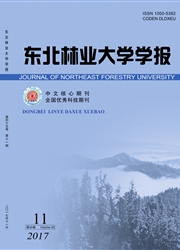

 中文摘要:
中文摘要:
利用木材近红外光谱数据建立反向传播(BP)神经网络模型,实现对木材树种的分类识别。以桉木、杨树、落叶松、马尾松、樟子松5个树种的296个样本的近红外光谱数据为研究对象,运用主成分分析对光谱数据进行降维,并以处理后的主成分数据作为分类模型的输入变量,分别建立了不同属的桉树和杨树以及同属的落叶松和樟子松的BP神经网络二分类模型;建立了桉木、杨树、落叶松、马尾松、樟子松5个树种的BP神经网络识别模型,并利用遗传算法和粒子群算法对5树种分类模型进行优化。结果显示,对于不同属木材,BP神经网络模型树种识别率可达100%,对于同属木材树种识别率也可达85%以上;对所建立的5树种识别模型,BP神经网络树种识别率有所下降,但正确识别率也均可达到75%以上,经过遗传算法和粒子群算法对模型的优化,木材树种平均识别率可分别达到84%和87%以上,表明遗传算法和粒子群算法可以有效提高木材树种识别率。
 英文摘要:
英文摘要:
We established the back propagation( BP) neural network model for timber recognition with the data of wood near infrared spectrum. We selected 296 spectral samples of Eucalyptus wood,poplar,larch,Pinus massoniana,and Mongolica as the research object,and the principal components as input variables of classification model after the data dimension reduction by principal component analysis. Then we established the BP neural network classification model of two tree species between eucalyptus and poplar,larch and mongolica respectively,as well as the BP neural network recognition model of five tree species which was optimized by genetic algorithm and particle swarm algorithm methods. For different wood,the recognition rate of BP neural network model for different general wood could reach 100%,and still reach more than 85%for congeneric wood. For five tree species identification model,the recognition rate of BP neural network dropped to 75%above,while timber species average recognition rates were above 84% and 87%,respectively,through the optimization model by genetic algorithm and particle swarm algorithm,Both genetic algorithm and particle swarm algorithm could improve timber species recognition rate effectively.
 同期刊论文项目
同期刊论文项目
 同项目期刊论文
同项目期刊论文
 期刊信息
期刊信息
